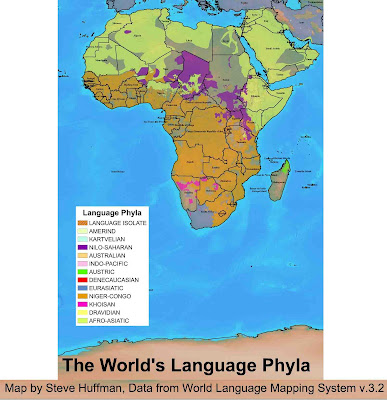BUT FIRST, A NOTE FROM OUR MONSTER
Before I do, I first want to tell you about a little something I keep forgetting to mention. Some time back, I gave you all the link to one of my favorite blog sites, Stefan Bucher's Daily Monster page. There's also a permanent link to it over there in the right sidebar. He's now doing a slightly different version, but for a while there, he was drawing monsters and posting sped-up videos of the monsters being drawn, or coming to life as it were. Visitors to his website, without any prompting, started posting their own little stories about the monsters, giving them names, histories, methods of birth, etc. Bucher started making his monsters more colorful, more people posted stories, everybody started having more and more fun.
And after 100 monsters, Stefan made a book out of the whole thing. A tangible, you-can-hold-it-and-turn-the-pages book. The book was released some time in February. I'm bringing this up now because I, your intrepid Apple Lady, was one of the people who submitted stories to the Daily Monster page, and some of my stories were selected for inclusion in Stefan's book. In return for those stories, Mr. Bucher kindly sent me a copy, which arrived at my door just the other day.

The book, as you can see, is called 100 Days Of Monsters, and you can buy it through Amazon for around $12. If you click on the link to the Amazon page, you can see shots of what the pages look like, and if you scroll down the Amazon page, you can get an idea of how Stefan Bucher's drawings and people's subsequent postings worked. Or you can just go to his Daily Monster page and see what he's up to now, which gives you pretty much the same idea.
The good thing about the book is that the stories are sampled down to some of the very best. And you can read the stories side-by-side with their respective monsters. The DVD that comes with the book allows you to see the animation of these particular monsters coming to life, which is really fun because he starts with a blob, and sometimes you think you can see the monster within the blob, but then he takes it in a different and usually delightfully surprising direction.
In the book, Mr. Bucher used everyone's real names, even though most people posted their stories online using screen names. So if you buy a copy and read the stories, perhaps you might be able to figure out the true identity of your Apple Lady (that is, if you don't know me personally already).
But even better than that, the monsters are really creative and slightly goofy, and some people's stories are wonderfully funny. I read several of the stories when the book arrived, and some of them made me laugh so hard and so long, I had to wipe tears from my eyes. And I'm not even talking about my own stories! (har har) I haven't read them all yet because I want to save some of them for the next time I need a really good belly-laugh.
So check out 100 Days Of Monsters (with DVD). I guarantee, you'll be glad you did.
NOW, BACK TO OUR BRAUNSCHWEIGER
Perhaps you may have noticed the occasional package of Braunschweiger in your grocery store's meat department. You can usually find it somewhere near the hot dogs or the bacon or the packaged lunch meats. I know I've noticed it, in the distinctive yellow and orange Oscar Mayer package, and I wondered what the heck it was.

What Braunschweiger looks like in the package and out of it, sliced. Kraft, which owns the Oscar Mayer brand, makes its own Braunschweiger, but they didn't have any pictures of it, nor did they even have any information about it on their website. The Braunschweiger in this photo is available from Bavaria Sausage, Inc.
- Turns out, it's liver sausage. Or, to be more German about it, liverwurst. Livers of various animals -- which animals seems to depend on who's making the sausage -- are seasoned and cooked and then smoked.
- Some people say the word "braun" in Braunschweiger means "smoked." But actually the name comes from the German town, Braunschweig, which gets Anglicized to Brunswick.
- In making your Braunschweiger, you could use pig livers, chicken livers, goose livers, or some combination thereof, whatever you prefer. Most people seem to use pork liver.
- You have to make sure you have enough fat so it'll stick together, so people generally recommend using pork liver that's about 50% fat, or else adding bacon fat or lard or whatever fat source you prefer. Cook it all up, then chill it. That will make the grinding easier.
- Once it's well-chilled, grind the mixture in your processor with salt and pepper and various spices -- many people recommend nutmeg -- until you've got a puree.
- Then pack that puree into some loaf pans, or get out your sausage casings and stuff. Refrigerate your pans or links for a couple of days, and Bob's your uncle, you've got Braunschweiger!
If you want to know more details about what spices to use when you make your Braunschweiger, or how to get your own pork livers right from the pig, check out some of these sources. I'll warn you ahead of time, some of these pages are not for the faint-of-stomach.
- Jack Schmidling Productions, Liver sausage & Braunschweiger
- Thurman Dwight Lane, Old Time Hog Killing, Sausage and Lard Making
- Ask the Meatman, Braunschweiger Recipe
- Butcher & Packer, Braunschweiger (Smoked Liver Sausage)
- Recipe Goldmine, Braunschweiger (Homemade Liverwurst) recipe
One slice has about 5 grams of fat. One slice of Oscar Mayer beef bologna, by comparison, has 8 grams of fat. One slice of Oscar Mayer Genoa salami has 3 grams of fat. So it seems to be not that much different nutritionally from other sausagey types of meat.
If you want to know what you can make with your Braunschweiger, lots of people seem to like it in dips or spreads:
- Recipe Zaar, Braunschweiger Spread with cream cheese and pickles
- cdkitchen, Braunschweiger dip with chili sauce and horseradish, in a Christmas tree mold
- Cooks.com, lots of recipes for Braunschweiger balls
- Recipe Goldmine, Corned beef and Braunschweiger pate
- Chow Hound, Things to do with Liverwurst
But you can always slice it and put it on a sandwich:
Here's what it looks like in sandwich form, this one called the Curse of '49, with Muenster Cheese, tomato, onion, and mustard. You can buy this sandwich for $6.25 from the Brown Bag in Columbus, Ohio.
And now you know.
Additional Sources
Fit Watch, Free Online Calorie Counter, Braunschweiger
Merriam-Webster dictionary, braunschweiger








